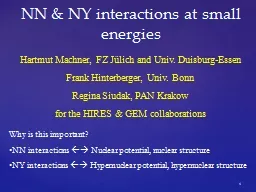

small energies Hartmut Machner FZ Jülich and Univ DuisburgEssen Frank Hinterberger Univ Bonn Regina Siudak PAN Krakow for the HIRES amp GEM collaborations Why is ID: 780323
Download The PPT/PDF document "1 NN & NY interactions at" is the property of its rightful owner. Permission is granted to download and print the materials on this web site for personal, non-commercial use only, and to display it on your personal computer provided you do not modify the materials and that you retain all copyright notices contained in the materials. By downloading content from our website, you accept the terms of this agreement.
Slide1
1
NN & NY interactions at small energies
Hartmut Machner, FZ Jülich and Univ. Duisburg-EssenFrank Hinterberger, Univ. BonnRegina Siudak, PAN Krakowfor the HIRES & GEM collaborations
Why
is
this
important
?
NN
interactions
Nuclear
potential
,
nuclear
structure
NY
interactions
Hypernuclear
potential
,
hypernuclear
structure
Slide2All possible interactions
Slide3Germanium
detector
Detectors: Big Karl + Ge-Wallfocussing spectrometer (W = 10 msr)high resolution Dp/p < 5
10
-5
combined
with
detectors
close
to
target
:
multi-layer
Germanium
detector
GEM
Slide4Particle
identification
NIM A 596 (08)311
Slide5Problem
Often the target or the beam is not available or even impossible. Way out: three body final states with fsi (Watson+Migdal theory):
factorisation:withleads to
Slide6FSI approaches
A lot of studies made use of a Gauss potential. However the Bargman potential is the potential which has the effective range expansion as exact solution: a, r a, b. a defines the pole position (positive ↔ bound, negative ↔ unbound).
Slide7The pp-case
Elastic pp scattering, Coulomb force seems to be well under controle: app=-7.83 fmHowever: an IUCF group
Claimed „…the data require app=-1.5 fm.“ They questioned the validity of the factorization.Experiment at GEM, differential and total cross sections.PRC 65(02)0641001
Slide8Modell
FSI
with Gamow factor, to account for Coulomb repulsionPRC 65(02)0641001
Slide9Projection of Dalitz
plot
Slide10pp
®ppp0
FIT Ss, Pp (Ps from polarisation experiments)blue: no D resonancered: with D resonance, usual fsiblack:
with
D
but
fsi
with
half the
usual
pp
scattering
length
No need for a change of the scattering length!
Slide11Connection bound-continuum
Fäldt & Wilkin derived a formula ( for small k)
From this follows, that from a the cross section of a known pole (bound or quasi bound) the continuum cross section is given [N(d)®N(pn)t®xN(pn)s].The fsi is large for excitation energies Q of only a few MeV.
type
pro
contra
single arm
absolute normalization of the triplet fraction
contamination from deuteron
double arm
no contamination from deuteron
no absolute normalization
best: an experiment avoiding the con’s.
®
high resolution single arm
Slide12Old analysis
Td=1600 MeV
singlettripletd+p®p+(
pn
)
Slide13Recent data Celsius
UppsalaPLB 446(99)179
Slide14GEM data
p=1642.5 MeV/c
PLB 610(05)31
Slide15Singlet FSI absolute
Slide16Triplet FSI absolute
Slide17Full spectrum
singlet fraction
Ref.0.40±0.05
Boudard et al.
< 0.10
Betsch et al.
<0.10
Uzikov & Wilkin
< 0.10
Abaev et al.
< 0.003
this work
first high resolution measurement allowing to study the threshold region of the d break up
fixed cross section for the unbound triplet state
the upper limit for the singlet break up contribution was reduced by a factor of 3
the ratio for unbound to bound state is < (1.9±0.5)
´
10
-3
Why is there no singlet state
?
The
isospin
related reaction to the singlet state is pp
®
pp
p
0
Slide18Data vs Fäldt Wilkin
Why
?Tensor force?PRC 79(09)061001(R)
Slide193 bodycalculation
withtensor forceRelativistic
phase spaceReid soft coreAlso necessity to normalize
Slide20It‘s not the tensor
force!What is
it then? Long ranging force!
Slide21pp
®K+Lp: why the forward Kaons under zero
degree?FSI as deduced from the present experimentKaons being forward emitted in thecm systemKaons being
backward
emitted
in the
cm system
Slide22Pbeam
=2735 MeV/c and 2081.2 MeV/c
Hyperon productionPLB 687(10)31
Slide23K
-
d2p-Lp: (Tai Ho Tan, PRL 23(69)695at =−2.0 ±0.5 fm and rt = 3.0±1.0 fmThree inputs13
2
Slide24Results
from 6 parameter fit
Slide25Total cross sections
Almost
isotropic Kaon angular distribution *4p
Slide26Comparison with exclusive
dataData: COSY TOFNo fit: input: total cross section given plus FSI
Slide27Data at
higher beam momentum
Slide28cusp
in pL due to tensor force?
Slide29Summary
We have measured pp®p0pp (full Dalitz
plot) Data and total cross sections can be discribed with standard parameters of pp FSI We have measured pp®p+np with very high missing mass resolution (DMM/MM=5*10
-5
)
FW
theorem
discribes
the
shape
of the
continuum
but
fails
to
give the absolute height
The
tensor
force
is
not the
origin
for
that
,
but
long
ranged
forces
We
have
measured
pp
®K
0
L
p at
two
beam momenta.
FSI
parameters
could
be
deduced
as
well
as
total cross sections. We see an enhancement at and below the SN thresholds.
Slide30What
this structure? - two
step process with kinematic matching? No, too large width - a cusp? (Nijmegen group:
in
3
S
1
channel
,
Haidenbauer
)
-
a
resonance
in
L
p
®
L
p
,
shoulder
from
S
+
n
®
L
p
(
Dalitz
:
fourth
sheet
pole) ?
-
bound
state
is
excluded
(no second
sheet
pole)
Summary cont
.
np
and
L
p
seem
to have opposite behavior in FSI:np almost only spin triplet, bound state existsLp almost only spin singlet, no bound state
exists